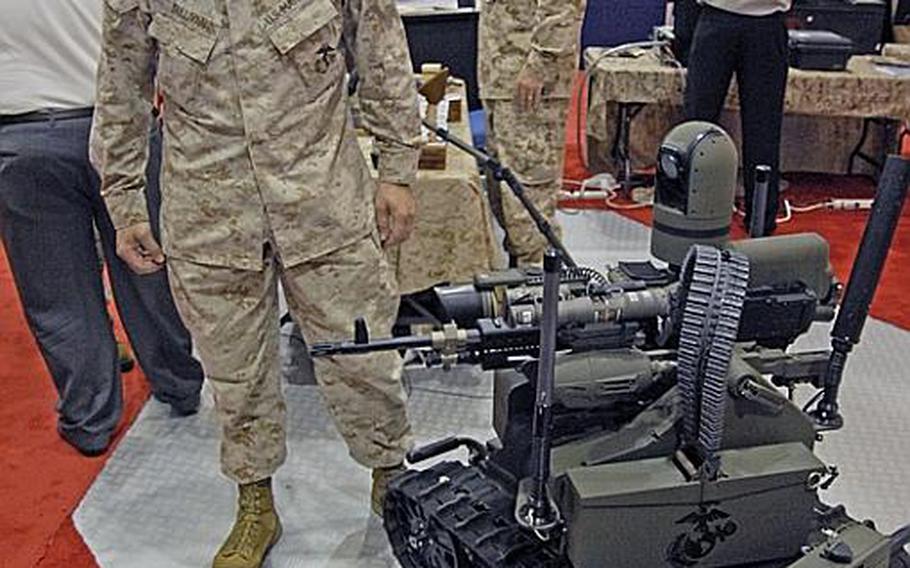
Gunnery Sgt. Steven C. Sullivan talks about how the remote-controlled Modular Advanced Armed Robotic System (MAARS) is being tested to augment machine gunners or act as a sentry or scout. The Marine Corps Warfighting Lab was displaying the robot at the Modern Day Marine convention in Quantico on Sept. 26, 2012. (C.J. Lin/Stars and Stripes)
QUANTICO, Va. — Continuing its quest to deploy robots on the battlefield, the Marine Corps is testing two new machines that could eventually work alongside troops — one a machine gun on wheels, the other a robotic pack mule.
The Marines recently reached a milestone in testing the Modular Advanced Armed Robotic System (MAARS), a remote-controlled machine gun outfitted with a camera, loudspeaker and laser.
It can now operate on voice commands, obeying about 40 cues including turning, stopping and aiming its turret in a specific direction. Shooting a target will still be controlled by the operator, although the robot will compensate for wind speed and range.
“It’s a huge leap forward,” said Gunnery Sgt. Steven C. Sullivan, project officer at the Marine Corps Warfighting Lab. “You no longer have a guy looking at a controller and taking his eyes off the surrounding areas.”
The MAARS will take to the field next month in a shooting demonstration to show off its aiming and optics systems at Fort Bragg, N.C.
“It’s a heightened-awareness machine gun,” Sullivan said. “The targeting camera can look out well past 1,000 meters and you can get pinpoint accuracy on target. You just put the dots on the target and pull the trigger.”
The Marines’ goal for the 400-pound machine, built by QinetiQ, is to augment machine gunners or act as an advanced scout or sentry, taking troops out of danger, Sullivan said.
“I can send a Marine out there and he can get shot, or I can send a robot out there that can look around, find a target, zoom in, destroy the target, and then make safe my danger areas so the Marines can process through,” Sullivan said. “I would rather give up a robot than a Marine.”
The Marines want the robot to operate off visual commands within two years, according to Sullivan.
Meanwhile, the autonomous Legged Squadron Support System (LS3) — a robotic mule that can carry up to 400 pounds of gear such as ammunition and water — will be tested at Fort Pickett, Va., in December, according to the Marine Corps Warfighting Lab.
The four-legged robot was designed by Boston Dynamics robotics company and has been undergoing testing by the Marines for the last three years. It would deploy with a small infantry squad.
“It’s modeled after a mule, except now you don’t have to feed it, and it’ll go wherever you tell it to go,” said Capt. Warren Watts II, project officer at the MCWL.
The machine uses a sensor system to avoid obstacles in its path, and it can climb over rocks and recover from falls on its spindly legs. It will be following alongside Marines on different terrains such as hills, mountains and wooded areas at Fort Pickett and then at Twentynine Palms, Calif., in March 2013. The Marines will be running the LS3 on various speeds and testing its waypoint navigation.
The robot is the latest high-tech venture the Marine Corps is considering as it looks at autonomous robots to carry equipment that can weigh 100 pounds or more, freeing troops from the load. The Marines have also been testing two load-carrying unmanned ground vehicles: a 7-ton cargo truck and a smaller robot that resembles a golf cart. But the LS3 will be able to go where those vehicles can’t, Watts said.
“When you have a wheeled autonomized system, it has to stick to a road network,” Watts said. The LS3 “can travel through different terrains … so it has to be able to articulate with its legs.”
linc@stripes.osd.mil Twitter: @cjlinSS